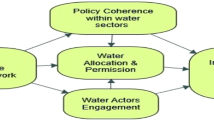Abstract
A main reason for the persistence of current water pollution lies in the diffuse character of many of its sources. For a large part such diffuse pollution is related to the production, use and waste of various kinds of products. For the reduction of this pollution, a product-oriented policy strategy, based on interaction with stakeholders could be more successful than the traditional measures of direct regulation that were devised for point source reduction. In this article we identify different types of product policy, and explore the potential benefits and costs for water quality management. The methods that can be used in a product policy approach are illustrated with some examples. Although the specific advantages for water quality management have not been quantified yet, governments increasingly recognise the potential positive effects. In this context, the European Water Framework Directive, in stimulating product policy by enhancing public and stakeholders’ participation, can be considered to be part of a general development towards interactive water management.
Similar content being viewed by others
References
Bakker, F. and De Gaspard, A., 2001, Product-Oriented Environmental Management: A Study of Capability Building, Stakeholder Orientation and Continuous Improvement Regarding Products’ Environmental Characteristics in Firms, Twente University Press, Enschede.
Barreveld, H. L., Berbee, R. P. M., Ferdinandy, M. M. A. and Van der Meulen, J. H. M., 2001, Vergeten Stoffen in Nederlands Oppervlaktewater, RIZA Rapporten 2001.020. Lelystad.
Boons, F. A., 1995, Produkten in Ketens: Een institutionele Analyse van de Substitutie van PVC-Leidingsystemen en Melkverpakkingen, Tilburg University Press, Tilburg.
Boons, F. A. and Baumann, H. (eds.), 2002, ‘Integrating greener product development perspectives’, J. Cleaner Prod. (Special Issue) 10(5).
EU, 1996, (European Union), Council Directive Concerning Integrated Pollution Prevention and Control, 1996/61/EC of 24 September 1996, L 257, 10/10/1996 p. 0026.
EU, 2000, (European Union), The Water Frame Work Directive, (Establishing a Framework for Community Action in the Field of Water Policy), 2000/60/EC of 23 October 2000, L 327, 22/12/2000 P. 0001.
EU, 2001, Integrated Product Policy, Green Paper on Integrated Product Policy, Commission of the European Communities, COM 2001, 68 final, Brussels.
EU, 2002, Integrated Product Policy, Website European Commission, http://www.europa.eu.int/comm/environment/ipp/integratedpp.htm
Frankl, P. and Rubik, F., 2000, Life Cycle Assessment in Industry and Business: Adoption Patterns, Applications and Implications, Springer –Verlag, Berlin Heidelberg.
Huppes, G., van den Berg, M., Schmidt, D., van Koten-Hertogs, M. and de Groot, W., 1986, Potenties van Produktbeleid, (The potential of product policy],CML-Mededelingen Nr. 26. CML, Leiden.
Le Blansch, K., 1996, Milieuzorg in Bedrijven, Thela Thesis (Ph.D. Dissertation), Amsterdam.
Le Blansch, K., Van Ast, J., Boons, F. and Slingerland, S., 2002, Potenties van Productbeleid voor Waterkwaliteitsbeheer, Research for the Ministry of Traffic, Public Works and Water Management, QA +, Den Haag.
Oosterhuis, F., Rubik, F. and Scholl, G., 1996, Product policy in Europe: New Environmental Perspectives,Prepared within the project ‘Product Policy in Support of Environmental Policy’, Kluwer academic publishers, Dordrecht.
Van Ast, J. A., 2000 , Interactief Watermanagement in Grensoverschrijdende Riviersystemen, Proefschrift Erasmus Universiteit Rotterdam, Eburon.
Van Ast, J. A. and Boot S. P., 2003, Participation in European water policy, in Physics and Chemistry of the Earth, Vol. 28, Pergamon, Elsevier, pp. 555–562.
Vethaak, A. D., Rijs, G. B. J., Schrap, S. M., Ruiter, H., Gerritsen, A. and Lahr, J., 2001, Estrogens and Xeno-Estrogens in the Aquatic Environment of the Netherlands Occurrence, Potency and Biological Effects, RIZA Rapporten 2002.001, Lelystad.
Author information
Authors and Affiliations
Corresponding author
Rights and permissions
About this article
Cite this article
Van Ast, J.A., Blansch, K.L., Boons, F. et al. Product Policy as an Instrument for Water Quality Management. Water Resour Manage 19, 187–198 (2005). https://doi.org/10.1007/s11269-005-2703-8
Received:
Accepted:
Issue Date:
DOI: https://doi.org/10.1007/s11269-005-2703-8




